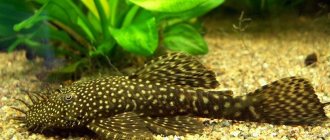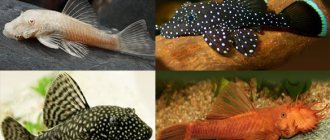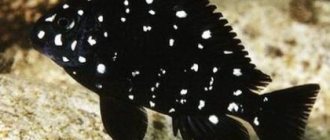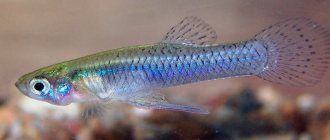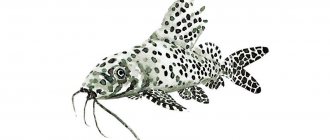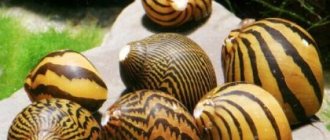Appearance Features
As a member of the Chainfish family (Loricariidae), Ancistrus stellata has a peculiar armor of bony plates on its body, which covers the back, but is absent on the ventral side. Like other catfish of this family, its body is slightly flattened and elongated in length. The suction cup-shaped mouth is equipped with scrapers that help catfish of this family scrape algal fouling from underwater objects.
Individual appearance features that distinguish the stellate from other types of ancistrus:
- Small white-bluish “stars” are scattered on the body and on the fins, which are black in color, which darken with age and acquire a brown tint.
- The dorsal and caudal fins of young fish are “decorated” in the form of a wide white stripe, which disappears in adult fish.
This color, clearly visible in the photo of Ancistrus stellata, is especially bright in young individuals, also attracts the attention of aquarists to this fish. Very similar appearance features are observed in the “star catfish”, which has a completely different Latin name (Ancistrus leucostictus) and is distributed only in the northern territories of South America. Sometimes these two species are “mixed” into one, and if it is important to you what type of catfish you buy in the store, ask for its Latin name.
Description
In nature, star catfish inhabit rivers, swamps and lakes of the Amazon, Brazil and Peru. They love reservoirs with rocky and clay bottoms. Juveniles are found in shallow waters, while adults are found in shaded areas.
Appearance
The maximum size of the oblong body is up to 9 cm. There are protective plates on the back. The color of the body and fins is black with small white dots. As the dots grow, they fade to brown. On the head there are dark eyes and a mouth with a suction cup and scraper. There are numerous branches. The fins of young star catfish are edged with white, which fades with age.
Character
Star ancistrus are peaceful and shy catfish that prefer a nocturnal lifestyle. During the day, unsociable fish hide in shelters and can freeze in one place for hours. They camouflage well. Skirmishes happen within a species. Newly acquired individuals are shy, but, having gotten used to it, they often come out of hiding and eat during daylight hours.
Lifespan
Ancistrus catfish lives on average 10 years.
Content
If you are a beginner aquarist, then feel free to purchase Ancistrus stellata, since this fish is completely unpretentious in keeping. The catfish sleeps all day and only in the evening begins to become active. Moreover, if the lighting is bright, then it will hide in the water thickets and snags of the aquarium.
It is important to note that Ancistrus stellata is a nurse fish. The fact is that in the aquarium, catfish eat food particles, cleaning the bottom, and also help fight certain types of algae.
Ancistrus males fight for their territory, so some clashes take place among themselves. However, they do not pose any danger to other fish. To avoid conflicts, this type of fish will require a fairly large aquarium - about 200 liters of water for an adult pair of fish.
It is better to keep these fish in groups of 7-8 individuals. In this case, the length of the aquarium must be at least 60 liters. It is recommended to equip the aquarium with various shelters, snags and caves, as well as thickets of aquarium plants. It is best to use heavy stones that lie firmly on the bottom of the aquarium, so that when the fish digs up the soil, they do not tip over onto the pet and inadvertently crush it.
Comfortable water temperature for star ancistrus is 20-28 degrees, pH 5.5-7, dH 2-15°. Food for catfish can be soft growths of some types of algae, but the main food is live or plant. As additional food, it is recommended to give Ancistrus scalded dandelion leaves or food in tablets for bottom fish.
Habitat in nature
This catfish was first described by Valenciennes in 1836. They are found in tributaries of the Amazon River, especially the Paraná River.
Previously they were known by other names, but subsequently the catfish of this group began to be assigned a number (in this case it is L181 ). For example, we wrote about Hypancistrus zebra L046.
The star ancistrus is not included in the international Red Book. It is also worth warning that the catfish does not end up in natural systems alien to it; although it is small, it can cause great harm to the biotopes of other countries.
The biotopes inhabited by the star ancistrus vary from fast-flowing waters with a rocky bottom to very slow waters with a clayey bottom. During the rainy season it can be found in flooded forests.
The starfish's natural diet is algae and plankton (microscopic inhabitants of the waters), with adults enjoying it in the deeper, darker areas, while juveniles can usually be found in the shallower, lighter areas.
Ancistrus stellata is part of the large group Ancistrini, which currently includes about 64 species.
Nowadays you can find several different variations of star ancistrus on sale; they differ from each other in small details and have not yet been sufficiently described.
They all have a certain number, but very often the classification is confusing and the differences are so small that juveniles of one species are sold under the guise of another. The most popular is L181 star ancistrus.
The main difference between Ancistrus stellata and its relatives is its peaceful nature and modest size; it can be kept even in small aquariums. In addition, they are popular because they are quite easy to breed.
Power and Compatibility
Star ancistrus are typical herbivorous fish. In nature, they eat bottom fouling and algae. In aquarium conditions, naturally occurring fouling of certain algae is a good food for them. This food must be supplemented with other plant foods (vegetables and herbaceous plants). Live food should also be given, but no more than a fifth of the daily ration.
Star ancistrus get along well and peacefully with any other species of aquarium fish. But in relationships with same-sex individuals of their species, they are very aggressive due to their territoriality. Males often get into real fights.
Differences between females and males
As with all loricaids, the adult male stellate ancistrus is easily distinguishable from the female. These differences appear starting from the seventh month: the male begins to grow long tentacles (leathery processes) on his face, which
grow all over the head (look at the photo of the male stellate ancistrus).
Females can also have such outgrowths, but they are shorter and their area of distribution is only along the edge of the upper jaw. The male's body is much longer than the female's.
Reproduction
Ancistrus stellata reaches sexual maturity at one year of age. At the same time, the length of the fish already reaches about 7-9 cm. A pair of catfish can spawn both in a common aquarium and in a separate spawning tank. At the same time, the water in the spawning tank has the same parameters as in a general aquarium.
Spawning is stimulated not by increasing, but by decreasing the water temperature and regularly replacing the water with fresh water. To breed Ancistrus stellata, you need to purchase a spawning substrate - a hollow plastic or ceramic tube about 20 cm and 3-4 cm in diameter. With this tube you can catch the eggs that the female lays in the shelter. The eggs are yellow in color and about 3 mm in diameter. Moreover, it is the male who will guard the eggs.
In the spawning tank, the female is removed after laying eggs, and if spawning occurs in a general aquarium, then the male and the tube with the clutch are moved to another container, the water parameters in which are the same as in the general aquarium.
After 3-4 days, the fry appear, and after a week they leave the tube and begin to feed on their own. It is recommended to feed the fry with plant food or live dust.
It is important to note that in the aquarium where the fry are located, it is necessary to place driftwood, which the young animals will be happy to peel off.
Owner reviews
Ancistrus stellata is a species that is not as popular as Ancistrus vulgaris, but its unpretentiousness and original appearance are optimally suited for keeping by beginning aquarists. These fish become most active in the afternoon, closer to night.
Despite the fact that males of this species of ancistrus are very territorial, any intraspecific skirmishes extremely rarely cause serious injuries.
Important! If artificial or natural lighting is too bright, it is unlikely that you will be able to observe catfish - the fish are very good at hiding under decorative shelters.
Experienced aquarists recommend placing decorative stones directly on the bottom of the aquarium, and not on the surface of the ground. Otherwise, the very first dig under such a stone can provoke crushing and death of the pet.
As practice shows, it is best to keep a couple of adult specimens in an aquarium with a volume of more than one hundred liters . Otherwise, Ancistrus is very unpretentious and its maintenance does not cause difficulties even if you have no experience in caring for aquarium fish.
Return to content
Feeding catfish fry "Ancistrus stellata"
The fry begin to be fed on the 4th day after the larvae emerge from the eggs. In the first days they are fed with the smallest plant foods. The nursery aquarium must contain driftwood and coconut shells, preferably old and well-soaked. From the first days the fry actively gnaw them. As the fry grow, they need to be switched to larger food. Over time, live food and algae tablets must be introduced into the fry’s diet.
It is best to take a large aquarium for raising fry. In volumes of 200-300 liters, the conditions for growing catfish are much more stable than in small aquariums, and this is the main requirement in the first 2 months of the life of ancistrus fry. It is important to keep the nursery aquarium clean. The water for fry should be as clean as possible, so it is necessary to remove any leftover food and change the water daily.
It is better not to transport the fry during the first months of life. This can have a negative impact on their health and can easily lead to death. It is best to transport fry when they reach the age of 5-6 months. At this age, they already reach a size of 5-7 cm and can tolerate transportation quite easily. In a new place, the grown fry adapt and take root much better.
Star ancistrus are quite secretive fish. They tend to hide in the daytime in shelters or in thickets of plants. Being nocturnal, they become active only in the dark. This especially happens in a new place, when they are not yet accustomed to new conditions. Over time, the fish become less shy. After being in the new aquarium for some time, they get used to it, come out of hiding and take food even during the day.
Feeding
Typical herbivores, star ancistrus feed primarily on algae. But in an aquarium they may not have enough of them. They do not damage plants, but may starve.
Nowadays it’s very easy to buy special food for ancistrus, in the form of tablets that don’t get soggy and sink to the bottom.
They are usually spirulina based and provide good nutrition for catfish. But it is also worth adding vegetables to the diet, such as zucchini, carrots, spinach, cucumbers - the star ancistrus will happily eat all of this.
It is better to feed twice a day, in small portions.
But they love star ancistrus not only for this, they are known as excellent algae fighters. As herbivores, they eat fouling from all surfaces in the aquarium, scraping it off with their mouthparts.
Also add driftwood to the aquarium for normal nutrition of the ancistrus stellata. He needs wood particles for normal digestion.
Diseases
Star catfish have strong immunity. When water is contaminated, aquarium inhabitants are susceptible to:
- Ichthyophthyriasis. The disease is known as “semolina.” White growths appear on the body, the pet loses appetite and does not leave the shelter. Treat the disease with drugs from a pet store based on copper sulfate or malachite green. Read the instructions carefully, because an excess of the drug is dangerous for aquarium inhabitants.
- Oxygen starvation. Hypoxia occurs more often at high temperatures. Cool the water and increase aeration. Another reason for lack of oxygen is overcrowding of the aquarium.
- Poisoning. Excess nitrites and ammonia provoke poisoning in ancistrus. For prevention, test the water with tests for the content of nitrogen compounds. Replace up to 40% of the water. Add conditioners that neutralize hazardous substances and increase aeration.
- Oodiniumosis. Another name is “velvet rust”. If you notice that the fish is itching against the decorations, trembling, or the skin is covered with a yellowish coating, increase the water temperature and pour copper sulfate into the aquarium, according to the instructions. Do not turn off the aeration during treatment.


